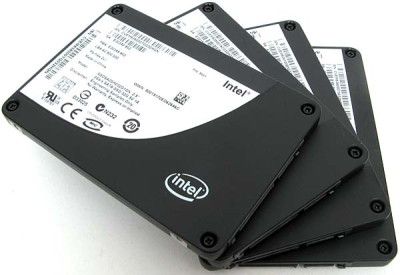From our front-page news:
Late last week, we linked to Tech Report's article on ACard's DDR2-based storage drive, which for the most part, was quite impressive. It was lacking the overall density we'd like to see, but it was fast, even keeping up in many tests to Intel's X25-E. Speaking of... happen to ever wonder what performance you'd see if you paired four of those together in RAID 0?
Well, Geoff apparently has, and he's put his ideas to paper and has some results to drool over. The first thing to consider is that Intel's X25-E is one heck of a drive to begin with. Although it's available only in a 32GB flavor, it offers 250 MB/s Read and 170 MB/s Write speeds... also known as really freaking fast. Pairing the four together didn't exactly quadruple the performance, but what was found is still rather impressive.
In the HD Tach synthetic test, the configuration achieved 560 MB/s Read and 515 MB/s Write, which, while not quite 4x, is still rather insane. At that consistent Write speed, you'd be able to fill up the entire 128 GB array in just under ~250 seconds. Real-world tests enjoyed pretty sweet gains in performance as well, over the single drive configuration, but for this kind of eye-popping performance, you're really, really going to want to have a good reason to part with the near $2,000 required to get the configuration going.

While the X25-E's dominating single-drive performance would surely satiate most folks, its target market is likely to seek out even greater throughput and higher transaction rates by combining multiple drives in RAID. The performance potential of a RAID 0 array made up of multiple Extremes is bountiful to say the least, and with the drive's frugal power consumption and subsequently low heat output, such a configuration should cope well in densely populated rack-mount enclosures. Naturally, we had to test this potential ourselves.
Source: Tech Report
Well, Geoff apparently has, and he's put his ideas to paper and has some results to drool over. The first thing to consider is that Intel's X25-E is one heck of a drive to begin with. Although it's available only in a 32GB flavor, it offers 250 MB/s Read and 170 MB/s Write speeds... also known as really freaking fast. Pairing the four together didn't exactly quadruple the performance, but what was found is still rather impressive.
In the HD Tach synthetic test, the configuration achieved 560 MB/s Read and 515 MB/s Write, which, while not quite 4x, is still rather insane. At that consistent Write speed, you'd be able to fill up the entire 128 GB array in just under ~250 seconds. Real-world tests enjoyed pretty sweet gains in performance as well, over the single drive configuration, but for this kind of eye-popping performance, you're really, really going to want to have a good reason to part with the near $2,000 required to get the configuration going.

While the X25-E's dominating single-drive performance would surely satiate most folks, its target market is likely to seek out even greater throughput and higher transaction rates by combining multiple drives in RAID. The performance potential of a RAID 0 array made up of multiple Extremes is bountiful to say the least, and with the drive's frugal power consumption and subsequently low heat output, such a configuration should cope well in densely populated rack-mount enclosures. Naturally, we had to test this potential ourselves.
Source: Tech Report
